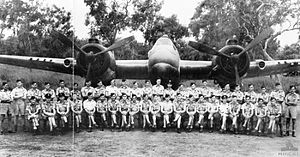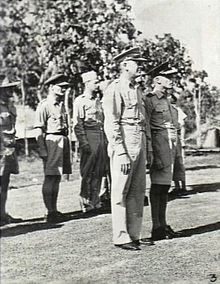- No. 9 Operational Group RAAF
-
No. 9 Operational Group RAAF 
Personnel of No. 30 Squadron, part of No. 73 Wing, No. 9 Operational Group, with a Beaufighter in New Guinea, 1943Active 1942–1944 Country  Australia
AustraliaBranch  Royal Australian Air Force
Royal Australian Air ForceRole Fighter; ground attack Size Two combat wings Engagements World War II Commanders Notable
commandersJoe Hewitt
Frank LukisAircraft flown Attack Beaufort; Beaufighter Bomber Hudson; Boston Fighter P-40 Kittyhawk No. 9 Operational Group was a major Royal Australian Air Force unit providing fighter, ground attack and anti-shipping support to the Allies in the South West Pacific theatre during World War II. It was designed to act as a mobile striking force independent of the RAAF's static area commands. As the war in the Pacific progressed, No. 9 Operational Group itself developed into an area command covering New Guinea.
Contents
History
No. 9 Operational Group (9OG) was formed in New Guinea in September 1942, consisting of seven RAAF squadrons attached to the USAAF's Fifth Air Force.[1][2] Four of the squadrons were based at Milne Bay and three at Port Moresby.[3] On its establishment it was the RAAF’s "premier fighting unit" in the South West Pacific Area (SWPA).[4] Its first commander was Group Captain Bill Garing.[5]
Administratively, 9OG initially came under the control of RAAF North-Eastern Area Command. On 1 January 1943, Headquarters 9OG assumed responsibility for the formation’s administration as well as its operations, making it independent of North-Eastern Area.[3] Air Commodore Joe Hewitt became Air Officer Commanding 9OG in February 1943.[4] The same month, the Group’s squadrons were reorganised into two wings: No. 71 Wing, covering the units in Milne Bay, and No. 73 Wing, those in Port Moresby.[3]
In March the group provided the RAAF's contribution to the Battle of the Bismark Sea, "the decisive aerial engagement" in the SWPA according to General Douglas MacArthur, resulting in twelve Japanese ships being sunk.[5] Between July and October 1943, 9OG was expanded to include a works wing and a radio location wing, its complement of operational squadrons totalling nine, plus a torpedo bomber detachment. Its aircraft carried out operations against enemy bases, shipping and lines of communication along the coast of New Britain.[3][6] In October–November the group launched a number of major assaults on Rabaul, bombing and strafing ground and naval targets.[7]
Although Hewitt was performing an "excellent job" according to Fifth Air Force commander Major General Ennis Whitehead, he was transferred from his post in November 1943 by the Chief of the Air Staff, Air Vice Marshal George Jones, over accusations of poor discipline within 9OG. He was replaced by Air Commodore Frank Lukis, who had commanded North-Eastern Area in 1942.[4][8]
In December 1943, 9OG's Kittyhawks took part in a series of attacks culminating in the Battle of Arawe.[9] As the Pacific conflict gradually shifted further north, however, operational tasking lessened and 9OG became colloquially known in the RAAF as the "Non-Ops Group".[10] It assumed the duties of a garrison force in New Guinea and was renamed Northern Command on 11 April 1944, to better reflect its new function. Its original mobile strike role was taken over by No. 10 Operational Group (later renamed the Australian First Tactical Air Force) which had formed on 13 November 1943.[2][11]
Order of battle
Upon its establishment in September 1942, 9OG consisted of the following units:
- Based at Milne Bay:
- No. 6 Squadron (Hudson)
- No. 75 Squadron (P-40 Kittyhawk)
- No. 77 Squadron (P-40 Kittyhawk)
- No. 100 Squadron (Beaufort)
- Based at Port Moresby:
In February 1943 the squadrons at Milne Bay became part of No. 71 Wing, while those at Port Moresby formed No. 73 Wing, both wing headquarters reporting to 9OG.[3]
Notes
- ^ Odgers, Air War Against Japan, p.6
- ^ a b Stephens, The Royal Australian Air Force, pp.144,168
- ^ a b c d e Odgers, Air War Against Japan, pp.23-24,35
- ^ a b c Stephens, The Royal Australian Air Force, pp.122-123
- ^ a b Stephens, The Royal Australian Air Force, pp.160-165
- ^ Odgers, Air War Against Japan, pp.71-84
- ^ Odgers, Air War Against Japan, pp.93-95
- ^ Odgers, Air War Against Japan, pp.102-103
- ^ Odgers, Air War Against Japan, pp.126-127
- ^ Stephens, Australian Dictionary of Biography, pp.135-136
- ^ Odgers, Air War Against Japan, pp.182-183,198-200
References
- Odgers, George (1968) [1957]. Australia in the War of 1939–1945: Series Three (Air) Volume II – Air War Against Japan 1943–1945. Canberra: Australian War Memorial. http://www.awm.gov.au/histories/second_world_war/volume.asp?levelID=67913.
- Stephens, Alan (2000). "Lukis, Francis William Fellowes". Australian Dictionary of Biography: Volume 15. Melbourne: Melbourne University Press. http://www.adb.online.anu.edu.au/biogs/A150167b.htm.
- Stephens, Alan (2006) [2001]. The Royal Australian Air Force: A History. London: Oxford University Press. ISBN 0-19-555541-4.
Categories:- RAAF groups
- Military units and formations established in 1942
- Military units and formations of the Royal Australian Air Force in World War II
- Based at Milne Bay:
Wikimedia Foundation. 2010.

